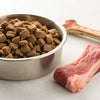Should You Feed Dogs Dry or Wet Food? A Comprehensive Guide
- Houndsy
Table of Contents
- Introduction
- Understanding Dog Nutrition
- Dry Dog Food: Pros and Cons
- Wet Dog Food: Pros and Cons
- Mixing Dry and Wet Dog Food
- Factors Influencing Your Decision
- Final Thoughts: Finding the Right Balance
- Frequently Asked Questions (FAQs)
Introduction
Did you know that nearly 70% of dog owners face the dilemma of choosing between dry and wet food for their furry friends? This common question often leads to confusion and concern for pet parents who want to ensure their dogs receive the best nutrition possible. The vast array of options available makes it challenging to determine which type of food best suits your dog's unique needs.
As dog lovers and passionate pet care advocates, we understand the significance of making informed choices about our pets' diets. Ultimately, the goal is to provide optimal nutrition while accommodating individual preferences and health requirements. In this blog post, we will explore the key differences between dry and wet dog food, delve into their respective benefits and drawbacks, and provide guidance on how to choose the right diet for your beloved canine companion.
By the end, you’ll have a better understanding of whether you should feed dogs dry or wet food. We invite you to reflect on your own feeding practices and consider how you can enhance your dog's feeding experience, perhaps even with the help of our innovative Houndsy Kibble Dispenser.
Understanding Dog Nutrition
Nutritional Needs of Dogs
Before diving into the specifics of dry and wet food, it's essential to grasp the fundamental nutritional needs of dogs. Just like humans, dogs require a balanced diet to thrive, which should include:
- Proteins: Essential for growth and development, proteins help repair tissues and generate hormones and enzymes.
- Fats: Healthy fats provide energy, support cell structure, and contribute to healthy skin and coat.
- Carbohydrates: While not essential, carbohydrates can provide energy and help with digestion through fiber.
- Vitamins and Minerals: These are crucial for various bodily functions, including immune response and bone health.
- Water: Adequate hydration is vital for overall health, and it's often overlooked in discussions about dog food.
Understanding these components helps us evaluate the nutritional value of both dry and wet dog food, ensuring we meet our dogs' dietary needs.
The Role of Moisture in Dog Food
One of the most significant differences between dry and wet dog food is moisture content. Dry food typically contains about 10% moisture, while wet food can range from 70% to 80% moisture. This difference plays a crucial role in hydration and can influence your dog's overall health.
For instance, dogs that do not drink enough water may benefit from wet food, which provides additional hydration. Conversely, dry food can aid in dental health, as the crunchiness encourages chewing, which can help reduce tartar buildup.
Dry Dog Food: Pros and Cons
Benefits of Dry Dog Food
- Convenience: Dry dog food is easy to store, measure, and serve, making it a practical option for busy pet owners. It doesn’t require refrigeration and has a longer shelf life once opened.
- Cost-Effective: Generally, dry food is less expensive than wet food, allowing pet owners to save money while still providing a balanced diet.
- Dental Health: The texture of dry kibble can help scrape away plaque and tartar as dogs chew, promoting better oral hygiene.
- Control Over Portions: It's easier to measure servings with dry food, allowing for precise portion control and helping to prevent overfeeding.
Drawbacks of Dry Dog Food
- Lower Palatability: Some dogs may find dry food less appealing, especially picky eaters or those with diminished appetites.
- Limited Hydration: Dry food lacks moisture, which could be a concern for dogs that do not drink enough water, particularly those with urinary or kidney issues.
- Potential for Overeating: Dogs may consume dry food too quickly, leading to digestive issues such as bloating.
Wet Dog Food: Pros and Cons
Benefits of Wet Dog Food
- Higher Moisture Content: Wet food provides additional hydration, making it an excellent choice for dogs that struggle to drink enough water.
- Enhanced Flavor: The rich aroma and taste of wet food can entice picky eaters and encourage dogs with low appetites to eat.
- Easier to Chew: Wet food is often easier for older dogs or those with dental issues to consume, as it requires less chewing.
- Satiety: Dogs may feel fuller after eating wet food due to its moisture content, which can be beneficial for weight management.
Drawbacks of Wet Dog Food
- Higher Cost: Wet food is generally more expensive than dry food, which can add up over time, especially for large breeds or multi-dog households.
- Storage Requirements: Once opened, wet food must be refrigerated and consumed quickly to prevent spoilage.
- Less Dental Benefit: Unlike dry food, wet food does not provide the same dental cleaning benefits, making regular dental care essential.
- Potential for Mess: Wet food can be messier than dry kibble, creating more cleanup for pet owners.
Mixing Dry and Wet Dog Food
For pet owners who want to maximize the benefits of both types of food, mixing dry and wet dog food can be an excellent solution. Here are some advantages and considerations for mixing:
Benefits of Mixing
- Variety: Mixing provides a range of textures and flavors, making mealtime more exciting for your dog.
- Balanced Nutrition: Combining both types of food can help meet nutritional needs while ensuring adequate hydration.
- Cost Savings: Using a smaller amount of wet food as a topper for dry kibble can enhance flavor while reducing overall costs.
Considerations for Mixing
- Caloric Control: It's vital to monitor your dog's caloric intake when mixing foods to prevent overfeeding. Consult your veterinarian to determine the appropriate portions.
- Food Compatibility: Ensure that both dry and wet foods are compatible in terms of ingredients and nutritional profiles to prevent gastrointestinal upset.
- Storage: Keep in mind the storage needs for wet food once opened, and be aware of the potential for spoilage if left out too long.
Factors Influencing Your Decision
Choosing between dry and wet food—or a combination of both—depends on various factors, including:
1. Dog's Age and Health
Puppies, adult dogs, and senior dogs have different nutritional needs. Puppies may benefit from the higher protein content found in certain wet foods, while senior dogs might require easier-to-chew options.
2. Activity Level
Active dogs may require more calories, and dry food's convenience can help with portion control. Conversely, less active dogs may benefit from the satiety provided by wet food.
3. Personal Preferences
Every dog is unique. Some may prefer the crunch of kibble, while others might enjoy the softness of wet food. Observing your dog's preferences can guide your decision.
4. Budget
Consider your budget. Dry food is usually more cost-effective, but mixing in wet food can enhance flavor without significantly increasing costs.
Final Thoughts: Finding the Right Balance
Ultimately, the choice between dry and wet food—or a combination of both—comes down to your dog's individual needs, preferences, and any health considerations. By understanding the benefits and drawbacks of each type of food, we can make informed decisions that enhance our pets' well-being.
If you're looking to simplify and elevate your dog's feeding experience, consider the Houndsy Kibble Dispenser. Our innovative design ensures perfect portion control, ergonomic convenience, and a stylish addition to your home decor. Explore our Houndsy Kibble Dispenser here and see how it can transform mealtime for you and your furry friend.
Frequently Asked Questions (FAQs)
1. Is it okay to mix dry and wet dog food?
Yes, mixing dry and wet dog food can provide a balanced diet and enhance palatability. Be mindful of portion sizes and consult your veterinarian for guidance.
2. How do I choose between dry and wet food?
Consider your dog's age, health, preferences, and activity level. Both types of food can provide balanced nutrition, so choose based on what suits your dog's lifestyle best.
3. Can I switch my dog from dry to wet food or vice versa?
Yes, you can switch your dog's food, but it's essential to do so gradually to avoid gastrointestinal upset. Mix the new food with the old food over several days to allow your dog's digestive system to adjust.
4. How much food should I feed my dog?
The amount of food depends on your dog's size, age, activity level, and health needs. Consult your veterinarian to determine the appropriate caloric intake for your dog.
5. What is the best way to store wet dog food?
Once opened, wet dog food should be stored in the refrigerator and consumed within a few days to prevent spoilage. Always check the packaging for specific storage instructions.
By understanding the nuances of dog food choices, we can ensure our furry friends lead happy, healthy lives. Let's make mealtime the best time for our pets!












